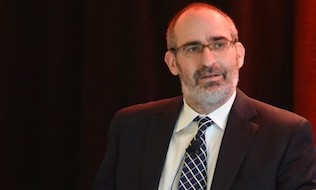

With the use of antidepressants rising significantly in the past two decades, it’s not just specialty drugs that are putting cost pressures on benefits plans, participants at Benefits Canada’s Calgary Benefits Summit heard on May 5.
According to data from Green Shield Canada (GSC), once plan members reach their 30s, the highest volume of drug claims is for antidepressants, a trend that continues into retirement.
In fact, in its latest study of health claims, GSC saw 13 per cent of all of its plan members making a claim for antidepressants. GSC, in conjunction with Cubic Health, looked even deeper at three years of antidepressant data and identified 35,000 plan members who began taking antidepressants during the study period. Based on prescribing patterns, the study found plan members suffering from severe clinical depression made up 12 to 15 per cent of the total.
“We see evidence of more robust treatment in this group,” David Willows, vice-president of strategic market solutions at GSC, told participants at the Calgary Benefits Summit.
In the remaining group, which consisted of 85 to 88 per cent of plan members starting antidepressants, prescribing and dosage patterns suggested they were suffering from mild to moderate depression with nearly half of them receiving a first dose that was below the minimum therapeutic level. A significant proportion of those plan members dropped off the medications entirely after the first fill and approximately 70 per cent had ceased pharmaceutical care before 135 days had passed. That’s below the standard six-month period it normally takes to measure the efficacy of an antidepressant.
Willows suggested there may be better treatment options for the second group, such as evidence-based and quality-controlled cognitive behavioral therapy.
“Does the care for mental-health patients and the whole mental-health system need to evolve so that physicians have options beyond giving a sub-therapeutic dose and seeing patients abandon treatment?” asked Willows, who sees the issue as a broader, system-wide concern. “It’s incumbent on all of us — the medical and benefits carrier community — to look for solutions to this problem.”
The need for change goes beyond mental health to encompass the entire area of health benefits. “With our examination of claims volumes and spending trends, we’re trying lay to rest the idea that we can continue to afford everything that people want and need in health benefits plans going forward,” said Willows.
With chronic disease and specialty drugs becoming the major cost drivers in benefits plans, “we need to do a much better job of managing and preventing chronic disease, and that will take an investment of new dollars,” said Willows.
A cost-effective strategy will require finding a way to get plan members to be physically active because, he noted, “exercise is medicine.”
In terms of pharmaceuticals, “we do need more amazing drugs,” said Willows, who thinks the insurance industry will have to negotiate differently with pharmaceutical companies around future pricing for high-cost drugs.
While there are legitimate concerns about drug costs, there’s compelling evidence they can save lives, he noted, suggesting they can have a much more positive impact on plan member health than some other components of health benefits plans, such as certain paramedical services.
In the end, advisors and sponsors may need to make financial calculations around maintaining popular services like massage and categorize them as compensation or perks, he said, distinguishing them from spending on chronic disease prevention and specialty medications.
What it all points to, said Willows, is that some companies will need to start to consider what it will cost to subsidize what legitimate research says plan members need to ensure health and productivity while spending a little less on some of the benefits people have grown to simply like and want.
Read more from Benefits Canada‘s 2016 Calgary Benefits Summit
